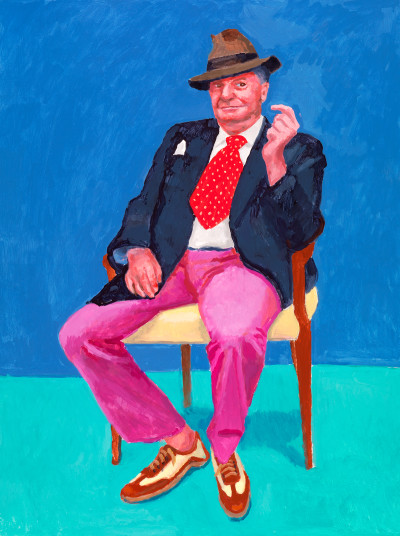Jenny puzzles over David Hockney's 82 Portraits and 1 Still-life
There is no living artist I admire more than David Hockey. I love his blend of fine draughtsmanship, hectic colour and shrewd portraiture. I have stood many times in front of his double portraits, most notably the magisterial tribute to his parents which now hangs in Tate Britain. Looking at this portrait you feel you know everything about these two beloved people. This lean, naturalistic, sculptural style of painting was characteristic of his earlier work. And his stylized LA paintings will always have glamour, sensuality and sweetness for me.
Age, deafness, illness and personal tragedy seem to have made little difference to David Hockney’s productivity or to the quality of his work. His output is prodigious. He experiments enthusiastically with different media, embracing technology along with traditional materials.

So I had high hopes of 82 Portraits and 1 Still Life at the Royal Academy. But this exhibition left me puzzled. The 82 portraits, created in acrylic at a hectic pace in 2015 and 2016, each over no more than three days, are tightly hung on violently vermilion walls with the names of the sitters elegantly inscribed above each. All the subjects were placed on the same yellow chair against a giddying turquoise backcloth.
The attention to detail in the sitters’ clothing is touching and funny. His sister, Margaret Hockney, who has been his subject many times, is portrayed wearing voluminous navy spotted harem pants. I recognized this garment immediately as the refuge of a certain sort of older lady who has lost contact with her waist. Rita Pynoos dressed up for her sitting by wearing a sumptuous long red skirt which starts somewhat strangely under her breasts and pools out in front of her so that you barely look at her face. One of the youngest sitters looks as if he has been dressed by his mommy as a little man, complete with shirt, tie, waistcoat, nicely laced shoes and an important notebook.
One curious feature of the exhibition is that its curator, Edith Devaney, is also one of the sitters.
This is not a series of portraits where the artist was trying to flatter – or maybe even to suggest likenesses, except casually. So would I have recognized Barry Humphries without the red kipper tie, slouchy hat and pink trousers? Possibly not, though I loved the sitter’s roguish twinkle. The people all have oddly foreshortened legs, though in most cases their shoes have been conveyed in loving detail. The faces are hectically flushed or else bleached of colour.
I was especially puzzled by the portrait of his close friend Celia Birtwell, the young star of another wonderful double portrait painted in 1971, Mr and Mrs Clark and Percy, and a ‘muse’ he has painted many times. In the 2015 painting, Celia looks dumpy, has been given staring, wobbly turquoise eyes and a dab of bright green on the end of her nose. But why?
Taken together, which I assume is what we are meant to do, this is more like an installation than separate portraits. It is warm, it is humorous, but what else? After a few moments they all began to blend into one another. It was overwhelming. I was not tempted to linger. As I left, I did not feel their eyes following me.
No comments:
Post a Comment